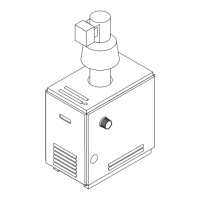MG & SG Series Boilers – Installation and Service Manual
8
2.5 AIR SUPPLY FOR COMBUSTION AND VENTILATION
A sufficient air supply MUST be provided to this boiler. Air openings to the boiler room provide the air for
combustion, flue gas dilution and ventilation and are always required, regardless whether the air is taken
from inside or outside. The air opening size and location (as well as other air supply and venting
considerations) must conform to Section 2.2.
The boiler room must never be under a negative pressure. Always provide air openings sized not only to
the dimensions required for the total input of all fuel-fired appliances in the boiler space, but also to
handle the air movement rate of any exhaust fans or air movers using air from the building or space.
The venting terminations must always be kept clear of obstructions (i.e. snow, ice, etc.). Louvers and
grilles used in the air supply and ventilation system should be kept clear of any dust, dirt, or debris which
will block proper air flow.
2.6 CORROSIVE ATMOSPHERES
If a gas boiler is to be installed near a corrosive or potentially corrosive air supply, the boiler should be
isolated from it and outside air should be supplied as recommended in Section 2.5.
Chemical vapors from products containing chlorine or fluorine must be avoided. Even though these
chemicals may be safe to breathe, corrosive substances can become liberated when passed through a
gas flame. Even at low concentrations, these chemicals can significantly contaminate the air supply and
shorten the life of any gas burning appliance. The following is a list of some of the products which should
be avoided:
• bleaches and chlorinated cleaning products
• paints and sprays
• water softeners (calcium or sodium chloride)
• leaking refrigeration equipment
• freon from common aerosol dispensers
These chemicals are especially commons near swimming pools, beauty shops, dry cleaning
establishments, laundry areas, workshops, and garages. The warranty is void when failure is due to
corrosion.
2.7 VENTING
The responsibility of providing a suitable vent of adequate draft capacity and in good usable condition is
that of the gas fitter/installer. Interference with the air supply for the boiler shall be prohibited.
Vent installation and type of gas vent or vent connector MUST follow all applicable national,
provincial/state, and local codes, laws, regulations, and ordinances as described in Section 2.2.
For boilers for connection to gas vents or chimneys, vent installations shall be in accordance with Part 7,
Venting of Equipment, of the National Fuel Gas Code, ANSI Z223.1 or Section 7, Venting Systems and
Air Supply for Appliances, of the CAN/CGA B149, Installation Codes, or applicable provisions of the local
building codes.
The venting shall be supported as required by applicable code(s). Horizontal runs shall slope upward not
less than ¼ inch per foot (21 mm/m) from the boiler to the vent terminal.
This unit must be installed with the factory supplied draft hood in place. The draft hood is a safety device
designed to control chimney drafts that might affect combustion or blow out the pilot. The draft hood
supplied with the boiler must not be altered. The minimum skirt height as indicated on the draft hood
must be maintained.
Vent connectors serving the boiler must not be connected into any portion of mechanical draft systems
operating under positive pressure.

